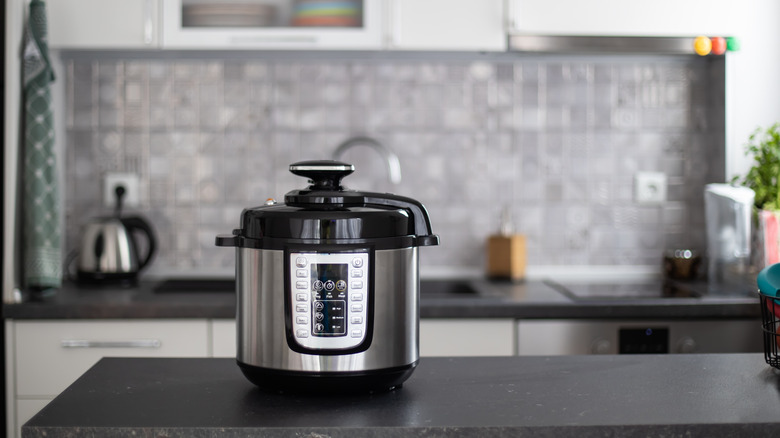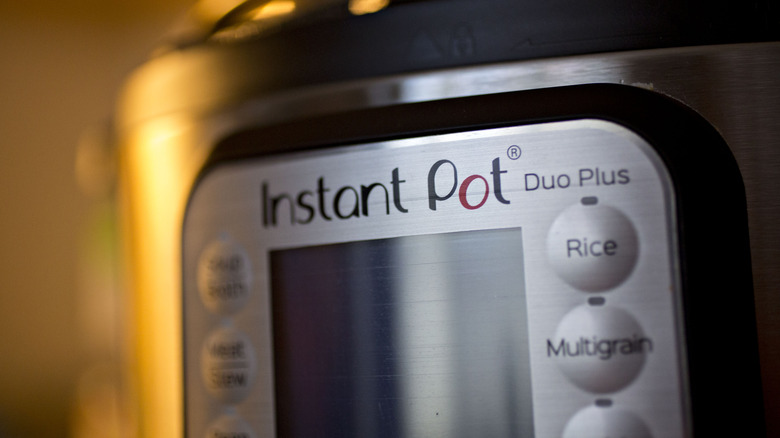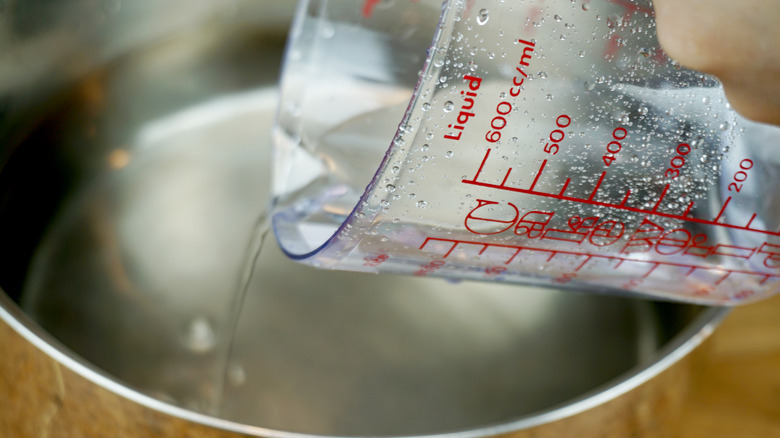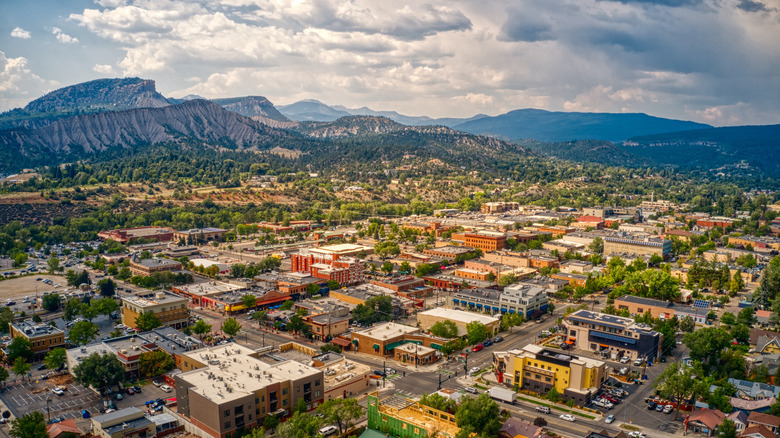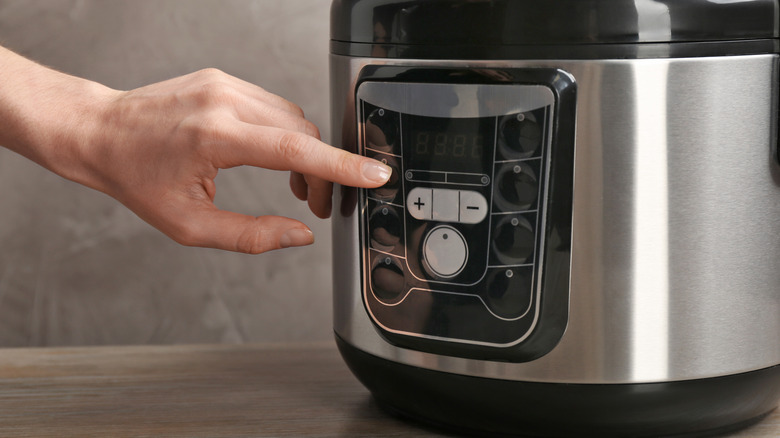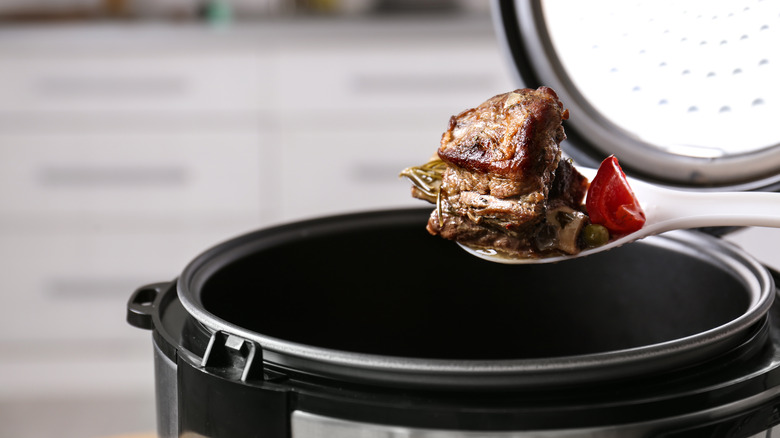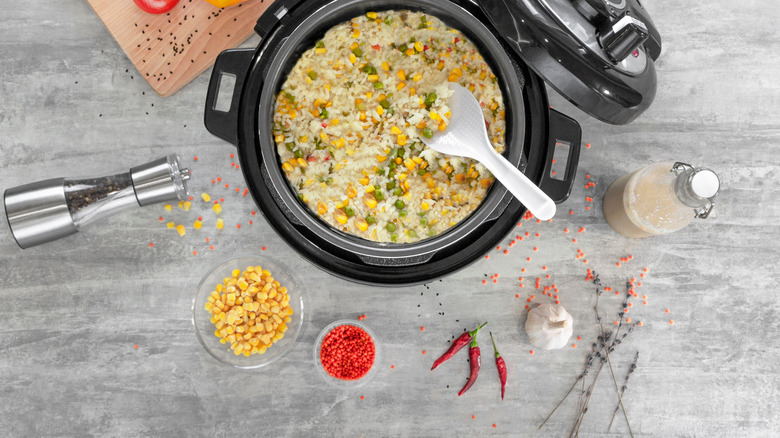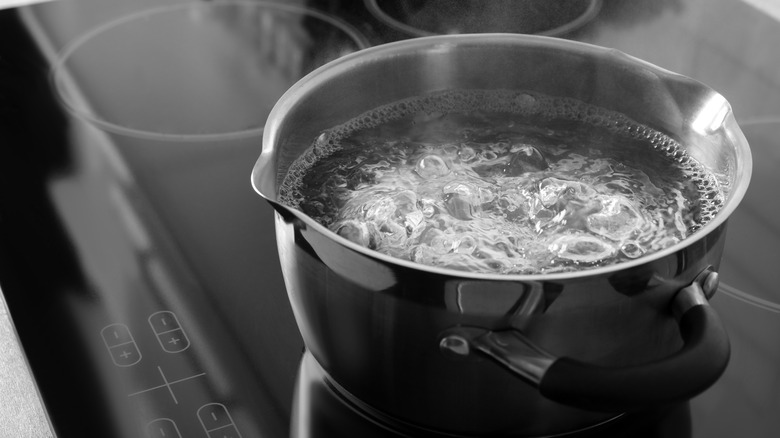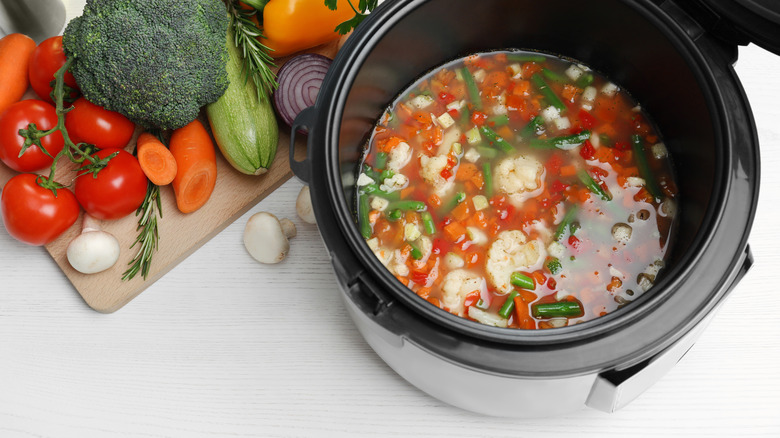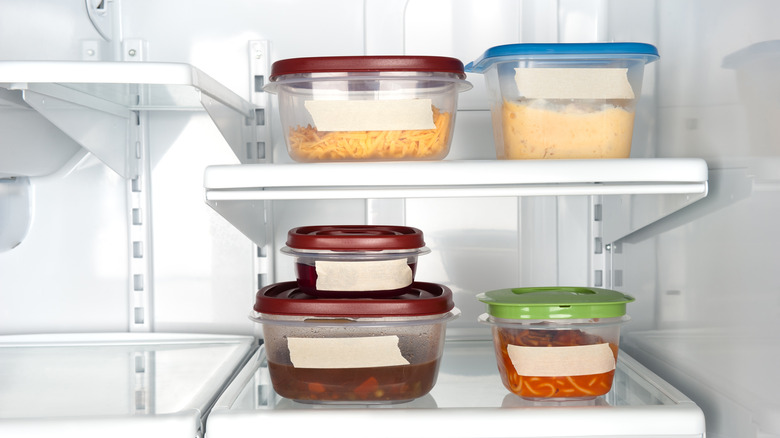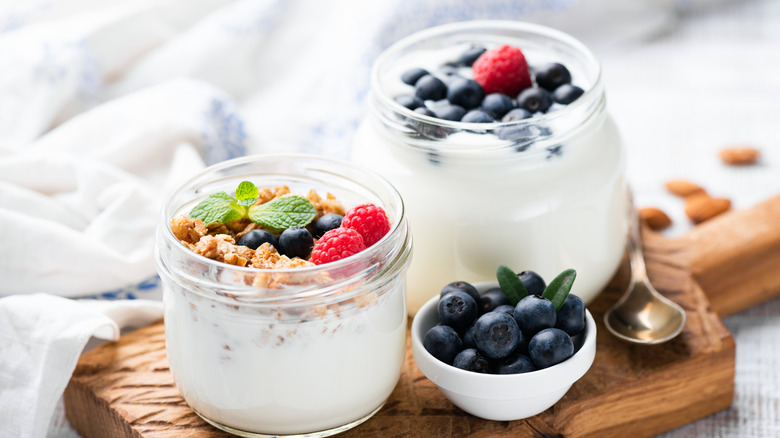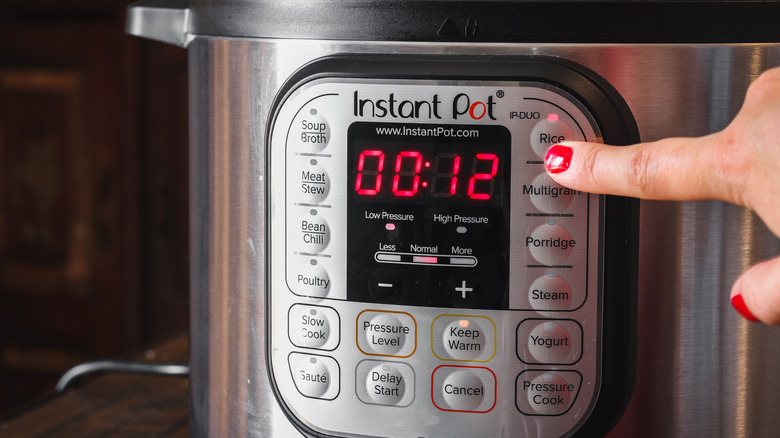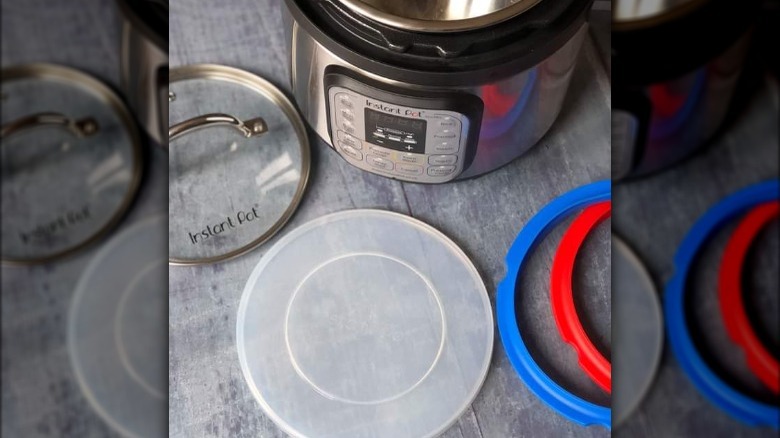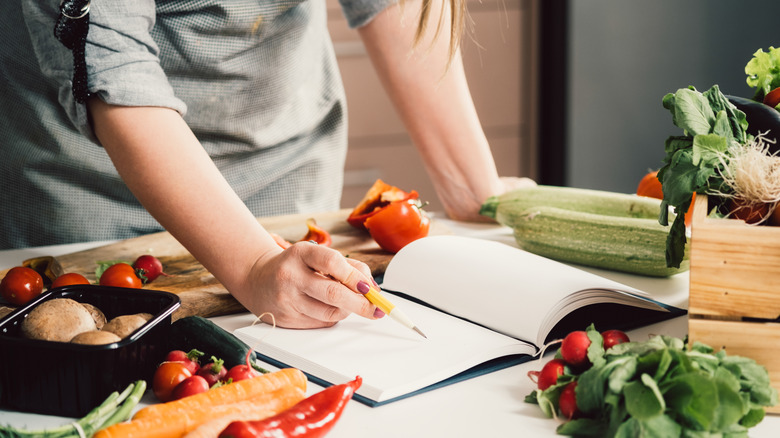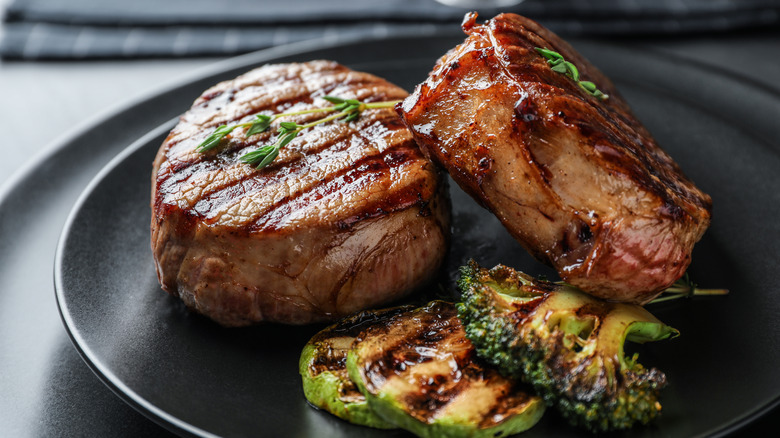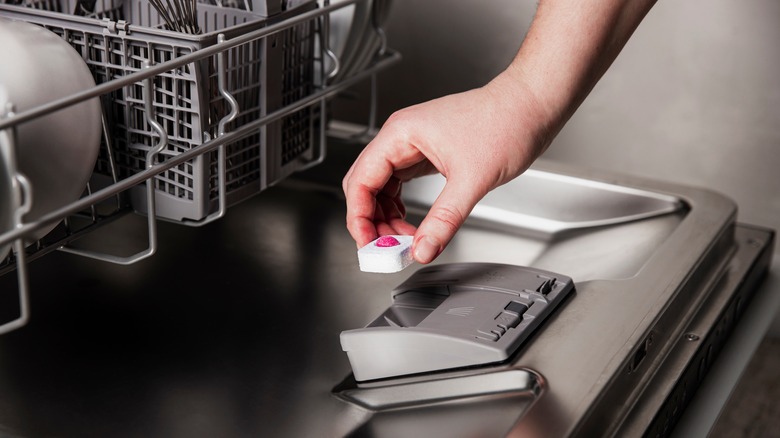Tips You Need When Cooking With A Pressure Cooker
We may receive a commission on purchases made from links.
If you ever watched your mom or grandmother use an old-school pressure cooker as a child, you probably saw them using a large, metal cylinder on the stovetop, filling it with water and letting it cook, often emitting a series of loud noises and a whole lot of steam in the process. They may have warned you about the pressure cooker's dangers by telling you some horror story about an exploding cooker that maimed a child who crept too close in the kitchen. The whole thing could've put you off cooking with one of these handy kitchen tools — but rest assured, today's appliances are not your mother's pressure cookers.
With the rise of the Instant Pot several years ago, a whole new generation of pressure cooker fanatics was born. Suddenly, home cooks could seemingly wipe away all their cooking woes with the help of a do-it-all countertop appliance. Cook a whole chicken from frozen? Sure. A pot of beans with no soaking? You got it. Rice, soups and stews, pasta, even cheesecake — no food was left untouched by the Instant Pot craze. And the best part? These newly-born pressure cookers were far easier to use than their retro counterparts — and safer, too.
However, despite how easy it is to use today's modern pressure cookers from brands like Instant Pot and beyond, these countertop appliances still come with their shortfalls. They're not foolproof. Here are a few tips you'll need when cooking with a pressure cooker.
Pick the right model or brand
If you're still exploring the various pressure cooker options out there, as you shop, consider all your options versus simply buying the flashiest brand you see on social media or at the big-box store. You can still find those stove-top pressure cookers like your parents or grandparents used and, for some, the aluminum cooking pot may be more desirable for its light weight and ease of storage. Electric pressure cookers are more popular now for myriad reasons, such as versatility and ease of use, though they can be a bit clunky and large.
When picking an electric pressure cooker, look at some of the best pressure cookers currently on the market and carefully consider the functions and features you want and need. The newest pressure cookers do so much more than just double as both a pressure and slow cooker. Some can also be used for sous vide cooking and air frying, while others come with handy apps for accessing pre-set cooking modes for hundreds of foods.
Conduct the water test
It may seem a little silly at first, but you do actually want to conduct a water test when you first bring home your new pressure cooker. If you've never used an electric pressure cooker, or any pressure cooker at all, the water test helps acclimate you to how an electric pressure cooker works. The water test only takes 20 minutes and is easy.
Just add three cups of water to your pressure cooker's inner pot and then close the lid. Some pressure cookers will chime to let you know the lid is properly in place and sealed. Once the lid is on, adjust your cooker's steam valve to the sealing setting. Then, set the cooker to its standard pressure cooking setting and set a cook time of five minutes. Let the pressure cooker do its work. It'll let you know when the cooking time is up, at which point you can try out the quick pressure release function by opening the steam valve manually. Conducting a water test before trying out a new recipe is a quick way to ensure you know how your new pressure cooker works, so you don't end up fumbling with unfamiliar settings while dinner's at stake.
Consider your altitude
Anyone who lives at a high altitude will tell you how much geography can really impact your cooking and baking. Unfortunately, the altitude can impact your pressure cooking as well and many home cooks have found that Instant Pots cook food more slowly at higher altitudes.
The atmospheric pressure is lower in high-altitude areas, such as in Colorado. So, when a cooker adds pressure to cook your food faster, the food, cooker, and environment are all already at a lower-than-normal atmospheric pressure. In other words, the cooker needs to work harder and longer to achieve the same effect that it might at sea level. Additionally, that atmospheric pressure also causes water to boil and evaporate quicker, which could mean a burnt dinner if you haven't added enough liquid to your pressure cooker before sealing it up. If you plan on cooking with an electric pressure cooker at a high altitude, consider increasing your cooking time (around half an hour, according to some consumers) and adding extra liquid to the chamber.
Don't always use the quick release setting
While you can cook just about anything in a pressure cooker, when you're cooking liquid-based recipes, like soups or stews, you'll want to avoid one key rookie mistake: using the cooker's quick release setting. While the quick release setting is convenient — sometimes you don't want to wait for the cooker to cool down and come to normal pressure on its own — the quick release valve works best for items you don't want to overcook, like large pieces of meat.
Take into consideration that, by using the quick release setting, you're drastically changing the cooking chamber's atmospheric pressure in a matter of seconds. While some foods can handle this, others ... not so much. Liquid-based recipes will splatter and steam quite a lot, which not only means you could lose half your meal to a giant kitchen mess, but you could also be putting yourself and family members at risk for painful burns.
Be careful removing items
When your pressure cooker has finished cooking and you've let the steam release naturally or via the quick release valve, it's time to remove your food. However, it's important to realize the food in your pressure cooker will be extra-hot, just like food you've just removed from the oven. Even if you've allowed the pressure cooker to naturally release its steam over as much as half an hour, it's still going to be piping. Take caution when removing all food and, if serving straight from the pot, don't leave utensils (especially plastic ones) in the pot or leaning against the metal side.
If you're using one of the cooking methods that requires you to cook your food in a separate pan inside the cooker's chamber (like if you're baking something), you can fashion a sling from aluminum foil to help remove it. Pressure Cooking Today recommends using several layers of aluminum foil folded into a long rectangle and sliding the foil beneath your pan before cooking. Once the food is cooked, you simply grab hold of both ends of the aluminum foil and lift the pan free.
Take special considerations for rice and pasta
While many electric pressure cookers feature a rice setting that can easily double as a rice cooker, you may not reach for your pressure cooker every time you cook pasta. Pressure cookers, after all, are known for turning rock-hard foods, from a frozen roast to raw potatoes, into soft and succulent meals in minutes; wouldn't a pressure cooker just turn pasta into mush?
Well, not quite. However, special considerations must be taken into account when cooking both rice and pasta, says Instant Pot. According to the pressure cooker manufacturer, when cooking pasta, always choose dry noodles that require a minimum cooking time of eight minutes. Then, only pressure cook your pasta for half the recommended time on the pasta box. Additionally, Instant Pot says rice is the only thing it recommends cooking on a low pressure setting; it also says, for rice, to never use the quick release valve right after the rice's cooking time is up. Instead, let the rice rest for five to 10 minutes, then use the quick release valve.
Speed up your cooking process
Yes, an electric pressure cooker is fast, but it can work even faster if you do two things. You've likely noticed that an electric pressure cooker, no matter what the cooking time is set as, takes a while to actually start that cooking time's countdown. This time period between when you sealed your food inside and when the pressure cooker actually starts cooking allows the cooker to build up that needed pressure and come to the correct temperature. Think of it like preheating your oven, but you have to pop your food inside and close the oven door before the preheating can begin.
As home cooks on Reddit can attest, you can speed up this "preheating" process by doing one of two things: never putting frozen food in your pressure cooker (it brings the temperature down) and, even better, boiling your liquid before adding it to the cooking chamber, to raise the temperature faster. Both of these will help your pressure cooker build pressure and come to temperature quickly, so the actual cooking can begin without a lengthy wait.
Don't overfill your pressure cooker
Over or under-filling your pressure cooker is a sure recipe for either a burnt or undercooked meal. As you learn everything you need to know about using your pressure cooker, you'll begin to discover what quantity of food or liquid is ideal for your cooker's particular size. However, the general rule of thumb is to never fill the pressure cooker more than two-thirds of the way full.
As your pressure cooker applies pressure to your food and cooks it under extreme conditions, the food can expand, steam, bubble, and foam, which requires extra space in the cooker. This is especially the case when cooking starchy grains like rice or legumes. If you overfill your pressure cooker, not only could you inadvertently clog the steam release valve, but you could also damage or break your pressure cooker permanently. For best results, check your pressure cooker's user manual, which should provide more exact instructions on how much or little food you can add to the cooking chamber.
Understand your pressure cooker's risks
While today's electric pressure cookers are far safer than the pressure cookers of yesteryear, it's still important to not fall for certain myths about pressure cookers that could be dangerous. For example, there's a misbelief that pressure cooking sanitizes your food, eliminating the risk of food poisoning and negating the need for refrigeration, which just isn't the case.
The only instance wherein you might be able to use your pressure cooker to sanitize food would be if you were pressure canning (a previously common use for stovetop pressure cookers), which requires much higher heat and a much longer cooking time than you might normally use when pressure cooking. So, the next time you pressure cook your favorite meal, don't think you no longer need to refrigerate your leftovers. Do as the USDA recommends and cool your leftovers quickly, to 40 degrees Fahrenheit or colder, and then store them in the fridge for up to four days.
Don't underestimate your pressure cooker
If you just took a gander at your pressure cooker's basic settings — like the soup setting, meat setting, rice setting, etcetera — then you maybe assumed your pressure cooker was only ideal for prepairing that handful of eight or nine items. However, this assumption may be causing you to miss out on some of the best uses for your pressure cooker. Turns out, there's a lot you can do with this singular countertop appliance.
Making homemade yogurt is one pressure cooker function that often gets overlooked. Scratch-made yogurt is not only fun, but affordable, environmentally friendly, and easy enough with an electric pressure cooker. The cooker can quickly bring your chosen yogurt containers up to the proper, bacteria-killing temperature, then maintain the right temperature for fermenting milk into yogurt. Similarly, making bone broth in an electric pressure cooker is also easy; while the traditional method requires you to watch a pot on the stove for 24 hours or so (also making your house smell pretty pungent) bone broth in the pressure cooker cuts down on both the odor and the time needed. You can even use your electric pressure cooker on one of its lower settings as a makeshift proofing drawer.
Try the pot-in-pot method
After you're fairly comfortable using your electric pressure cooker's basic settings and you've conquered the world of pressure cooked weeknight dinners in a snap, consider expanding your use of your pressure cook by trying the pot-in-pot method. Pressure Cooking Today says the pot-in-pot method is particularly handy if you want to cook multiple items in your pressure cooker for one meal, or you want to use your pressure cooker for a baking project.
To use the pot-in-pot method, you'll need to simply use your pressure cooker's trivet and an oven-safe dish. Add water or another liquid to the bottom of your pot, then the trivet, and then the oven-safe dish atop the trivet. Your ingredients go in the oven-safe dish. If you're cooking two items at once, you can cook the item that needs more liquid, such as a pasta, soup, boiled veggies, or parboiled chicken, on the bottom layer, in the actual cooking pot, then cook your other item, like rice, in the oven-safe dish above it.
Use pressure cooker accessories
If you thought your pressure cooker could do it all, on its own, you'll be wow-ed when you realize just how much more it can do once you start stocking up on pressure cooker accessories. From the most simple to the more complex, you can likely find pressure cooker accessories that will make pressure cooking your favorite meals that much easier.
Steamer baskets make cooking vegetables or dumplings easy and seamless, without the need to dump your food into your cooking liquid. Silicone cooking slings make it simple for you to remove extra cooking pans from the pressure cooker without relying on a homemade aluminum foil sling or risking burning your fingers. Pressure cooker silicone molds help you easily make egg bites or cheesecakes. Many pressure cooker brands also offer extra lids or silicone sealing rings, so you can replace broken items or swap out worn pieces for new ones, without investing in an entirely new pressure cooker.
Convert your favorite recipes
Don't limit yourself to only using your pressure cooker for recipes you find in pressure cooking-specific cookbooks or blogs. You can convert many of your tried-and-true favorite recipes into pressure cooking preparation, as Pressure Cooking Today explains.
The blog says that to convert your recipe, consider how long you'd normally cook the main component of the dish and then cut that time in two-thirds for meat or in half for soft items like pasta. Cook the recipe on the pressure cooker's general high pressure setting and then use the quick release or natural release depending on the ingredients. Very wet ingredients benefit from a natural release, while items that you don't want to overcook, like meat, do better with a quick release after the cooking time is up. In general, the best recipes to convert are the ones that take the longest to cook via other methods, such as large volumes of meat or slow-simmered soups.
Know what not to cook in a pressure cooker
Pressure cookers are awesome at cooking a wide variety of foods. However, pressure cookers aren't ideal for cooking absolutely everything and opting to not use your appliance under some circumstances can save you both a mess and a ruined meal. Steer clear of foods that are quick-cooking anyway — things that you might pan-fry or grill, for example.
One of the main things to remember when choosing what to cook in your pressure cooker is that a pressure cooker won't give you a good crust or sear (and this is why you should rethink cooking foods like steak in a pressure cooker), even though it can cook food quickly, at a high temperature. Of course, many pressure cookers can be used to saute, which will give you some browning, but then, often, pressure cooker recipes that tell you to use the saute feature then ask you to pressure cook your food further. This eliminates a lot of that crunchy crust; the sautéing, in these instances, is more about flavor than texture. While you could use the cooker's saute function on its own, you may find that not quite as convenient as simply sautéing on the stovetop.
Don't throw your pressure cooker in the dishwasher
So you've successfully cooked up a delicious, pressure-cooked meal and now it's time for clean up. Luckily, if you've made a one-pot dinner in your pressure cooker, you have relatively little to clean. However, don't make the mistake of just throwing your pressure cooker into the dishwasher. Cleaning an electric pressure cooker is a little more complex.
First, remove your pressure cooker's cooking chamber and wipe away any residue. You can put this part of your pressure cooker into the dishwasher with no worries. To clean the pressure cooker lid, though, you'll have to take it apart. On most models, the lid's shield, float valve, and pressure release valve are all removable. You can pop them off and, depending on the model, toss them in your dishwasher's silverware receptacle. You can also remove the lid's sealing ring and toss that in the dishwasher's top drawer. For some models, the rest of the lid, once all parts are removed, is dishwasher safe. But, that's not the case with every model. Check your pressure cooker's user manual for further guidance.
